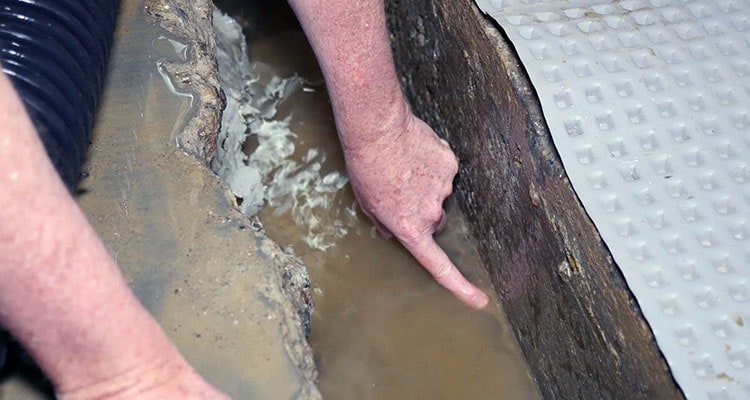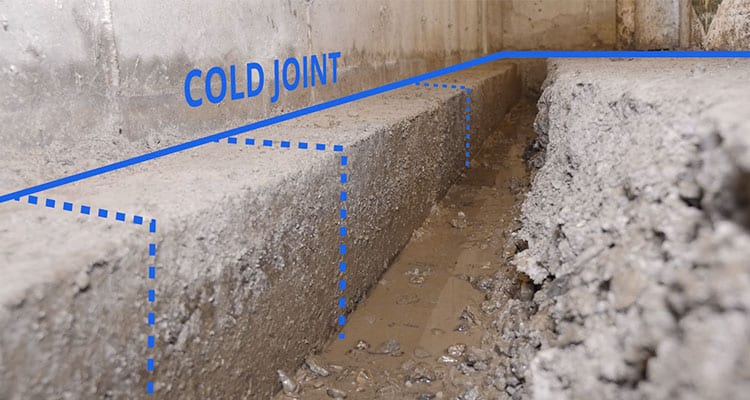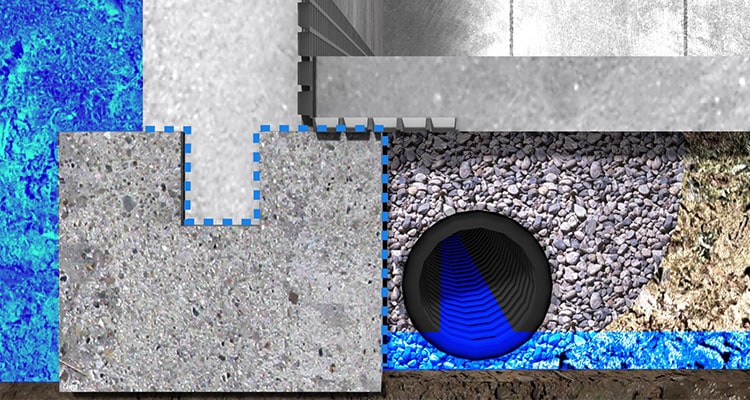How to Effectively Control Wet Basement Seepage

Share this Post
If you want to control wet basement seepage, there are many choices, but there is only one way to stop it from ending up on your basement floor. We are going to tell you how.
Table of Contents
Causes of Water Seepage in the Basement
Basement seepage is not an accident; it is a natural occurrence produced by the erosive properties of groundwater. No one can permanently stop groundwater in its attempt to enter your basement. Water always finds a way in. What is the solution to creating a dry basement if we cannot stop it?

Microscopic water molecules carry all kinds of minerals and elements that break down concrete. Water will squeeze through the cold joint between your wall and floor, through a wall or floor cracks, and along a stairway leading to the basement.

What is the Difference Between Water Seepage and Basement Leaks?
Water seepage and basement leaks refer to water infiltration into a building or structure, but they are slightly different terms.
Water seepage refers to the gradual infiltration of water through small cracks or porous materials, such as concrete or brick. It often occurs over a long time and may not be immediately visible.
Basement leaks, on the other hand, refer to more sudden and apparent water infiltration, usually through a hole or a break in a pipe or other water-carrying structure. Water leakage can cause more obvious and immediate damage than seepage.
In summary, water seepage is a slow and gradual process of infiltration, while water leakage is a sudden and more obvious process. Both of them can cause damage if left unaddressed.
Temporary Solutions
Temporary fixes such as waterproof paint and Drylok cement may initially appear effective in addressing basement seepage, but they are less effective in the long run.
Waterproof paint creates a barrier on a concrete wall’s surface, aiming to prevent water from seeping through. While it may appear to work for a short period, waterproof paint cannot withstand the hydrostatic pressure that groundwater can exert on the basement walls. Over time the paint may crack, peel, or blister, allowing water to seep in again.
Drylok cement is another temporary fix that aims to seal and waterproof the surface of the basement walls. While this cement does form a barrier against water, it is also vulnerable to constant pressure from groundwater. The cement may eventually crack or deteriorate, allowing water to find another way in or overwhelm the patch.
In both cases, these temporary solutions fail to address the root cause of the problem: the presence and pressure of groundwater surrounding the basement. As a result, even if they buy homeowners some time, groundwater will likely find another way in or create new leaks in the same spot within three to six months. Thus, in the long run, these temporary fixes are insufficient in providing a lasting solution to basement seepage.
Long-Term Solution to Keep a Basement Dry
The one true solution that wins repeatedly is an adequately installed basement drainage system with a sump pump to discharge water. Nature is relentless and lacks prejudice. Your basement is taking on water because the ground in your area perks more groundwater than in other places.
Another way of putting it; the forces of nature created a roadway to go around and underneath your house. Your house is blocking this roadway.
The best way to keep water from ever entering your home is by building a roadway that can be more easily traveled: a drainage system. We use a pitched 4″ pipe deep below your floor, several hundred pounds of wash stones, a flow channel along the walls, a vapor barrier, and a proprietary waterproof concrete mix called SuperCrete.

Finally, the drainage pipes, 10 to 12 inches below your floor, are pitched to a sump basket with a 3/4 horsepower sump pump inside. A discharge pipe made of PVC (polyvinyl chloride) sends collected water from the sump pump out and away from your house into a dry well or city sewer system.
FAQ
-
What is basement seepage?
Seepage is water infiltration into a basement through cracks in the foundation or walls.
-
What causes foundation seepage?
Various factors, including poor drainage around the foundation, a high water table, and faulty or clogged drainage systems, can be the cause.
-
How can I tell if my basement is experiencing water infiltration?
Signs of water seepage include water stains on walls or floors, musty odors, and wet areas.
-
Can I fix the foundation seepage on my own?
While some simple solutions that homeowners can try, such as redirecting downspouts away from the foundation and installing a sump pump, most problems require the expertise of a professional.
-
What are some standard solutions for foundation seepage?
Standard solutions for seepage include installing a sump pump, waterproofing the foundation and walls, and installing a drainage system.
-
How much does it cost to fix the seepage?
The cost of fixing water problems can vary depending on the cause and extent of the problem. Still, it can range from a few hundred dollars for simple solutions to several thousand dollars for complex repairs.
-
Are there any long-term effects of not fixing seepage?
If left unaddressed, basement water infiltration can lead to structural damage, mold growth, and health hazards. It is vital to address the problem as soon as possible to prevent further damage and protect the health of the occupants of the building.
Learn More! By reading our page: FRENCH DRAIN INSTALLATION, you get more information about safeguarding your basement from water seepage.
Schedule a free, no-obligation inspection and quote at no cost.